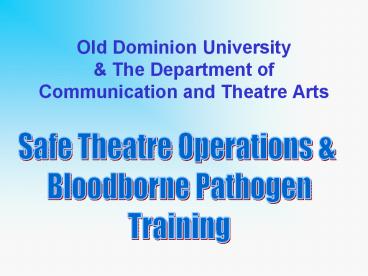Old Dominion University PowerPoint PPT Presentation
1 / 24
Title: Old Dominion University
1
Old Dominion University The Department of
Communication and Theatre Arts
Safe Theatre Operations Bloodborne
Pathogen Training
2
WHY ARE WE HERE?
- OSHA BB Pathogen standard
- anyone whose job requires exposure to BB
pathogens is required to complete training - employees who are trained in CPR and first aid
- Live Performances which place intensive physical
demands on performers and technicians will
increase risk of accidents! - The more you know, the better you will perform in
real situations!
3
ODU Live Performance Safety Procedures
- In the event of an accident during a rehearsal or
performance - 1st assess the situation and determine if medical
assistance is required. - 2nd if necessary call University Police
(68)3-4000 and request immediate assistance. - 3rd University Police will assess and call for
medical assistance. - As a First Responder
- Make sure that injured person is removed from
danger of further injury. - If bleeding take action to reduce or stop
further bleeding. DO NOT ATTEMPT TO ADMINISTER
FIRST AIDE BEYOND THIS! WAIT FOR Emergency
Medical Techs AND UNIVERSITY POLICE. - Clean and disinfect any fluid spills. Take
necessary precautions by using proper protection
and dispose of bio-hazard properly. These
procedures are described later in this document.
4
What is a BB Pathogen?
- Microorganisms that are carried in the blood that
can cause disease in humans
5
Common BB Pathogen Diseases
- Malaria
- Brucellosis
- Syphilis
- Hepatitis B(HBV)
- Hepatitis C(HCV)
- Human Immunodeficiency Virus (HIV)
6
Human Immunodeficiency Virus (HIV)
- HIV is the virus that leads to AIDS
- HIV depletes the immune system
- HIV does not survive well outside the body
- No threat on contracting HIV through casual
contact
7
Hepatitis B (HBV)
- May lead to chronic liver disease, liver cancer,
and death - Vaccination available since 1982
- HBV can survive for at least one week in dried
blood - Symptoms can occur 1-9 months after exposure
- 11.25 million Americans are chronically infected
- Symptoms include jaundice, fatigue, abdominal
pain, loss of appetite, intermittent nausea ,
vomiting
8
Hepatitis C (HCV)
- Hepatitis C is the most common chronic bloodborne
infection in the United States - Symptoms include jaundice, fatigue, abdominal
pain, loss of appetite, intermittent nausea,
vomiting - May lead to chronic liver disease and death
9
Potentially Infectious Bodily Fluids
- Skin tissue, cell cultures
- Any other bodily fluid
- Blood
- Saliva
- Vomit
- Urine
- Semen or vaginal secretions
10
Transmission Potential
- Contact with another persons blood or bodily
fluid that may contain blood - Mucous membranes eyes, mouth, nose
- Non-intact skin
- Contaminated sharps/needles
11
Your Exposure Potential
- Industrial accident
- Administering first aid
- Post-accident cleanup
- Handling of returned product
- Janitorial or maintenance work
- Handling of any waste products
12
Universal Precautions
- Use of proper PPE
- Treat all blood and bodily fluids as if they
are contaminated - Proper cleanup and decontamination
- Disposal of all contaminated material in the
proper manner
13
Personal Protective Equipment (PPE)
- Anything that is used to protect a person from
exposure - Latex or Nitrile gloves, goggles, CPR mouth
barriers, aprons, respirators
14
PPE Rules to Remember
- Always check PPE for defects or tears before
using - If PPE becomes torn or defective remove and get
new - Remove PPE before leaving a contaminated area
- Do not reuse disposable equipment
15
Decontamination
- When cleaning up surfaces use Hepacide Quat
- Do an initial wipe up
- Spray and allow it to stand for ten minutes then
wipe up - Dispose of all wipes in biohazard containers
- PPE should be removed and disposed of in
biohazard containers
16
Hand Washing
- Wash hands immediately after removing PPE
- Use a soft antibacterial soap
- A hand sanitizer can be used but wash with soap
and water as soon as possible.
17
Regulated Medical Waste
- Liquid or semi-liquid blood or other potentially
infectious material(OPIM) - Contaminated items that would release blood or
OPIM when compressed - Contaminated sharps
- Pathological and microbiological waste
containing blood or OPIM
18
Signs Labels
- Labels must include the universal biohazard
symbol, and the term Biohazard must be attached
to - containers of regulated biohazard waste
- refrigerators or freezers containing blood or
OPIM - containers used to store, transport, or ship
blood or OPIM
19
Exposure Incident
- A specific incident of contact with potentially
infectious bodily fluid - If there are no infiltrations of mucous membranes
or open skin surfaces, it is not considered an
occupational exposure - Report all accidents involving blood or bodily
fluids - Post-exposure medical evaluations are offered
20
Post-exposure Evaluation
- Confidential medical evaluation
- Document route of exposure
- Identify source individual
- Test source individuals blood (with individuals
consent) - Provide results to exposed employee
21
Hepatitis B Vaccination
- Strongly endorsed by medical communities
- Offered to all potentially exposed employees
- Provided at no cost to employees
- Declination form
22
Recordkeeping
- Medical records include
- Hepatitis B vaccination status
- Post-exposure evaluation and follow-up results
- Training records include
- Training dates
- Contents of the training
- Signature of trainer and trainee
23
In Conclusion
- BB pathogen rules are in place for your health
and safety - Failure to follow them is a risk that does not
need to be taken. - Heres another website for more information
- http//www.usg.edu/ehs/training/pathogens/7.phtml
24
Questions?
Old Dominion University Environmental Health
Safety1007 S. Webb CenterNorfolk, VA
23529(757) 683-3132 - PHONE(757) 683-5930 - FAX

